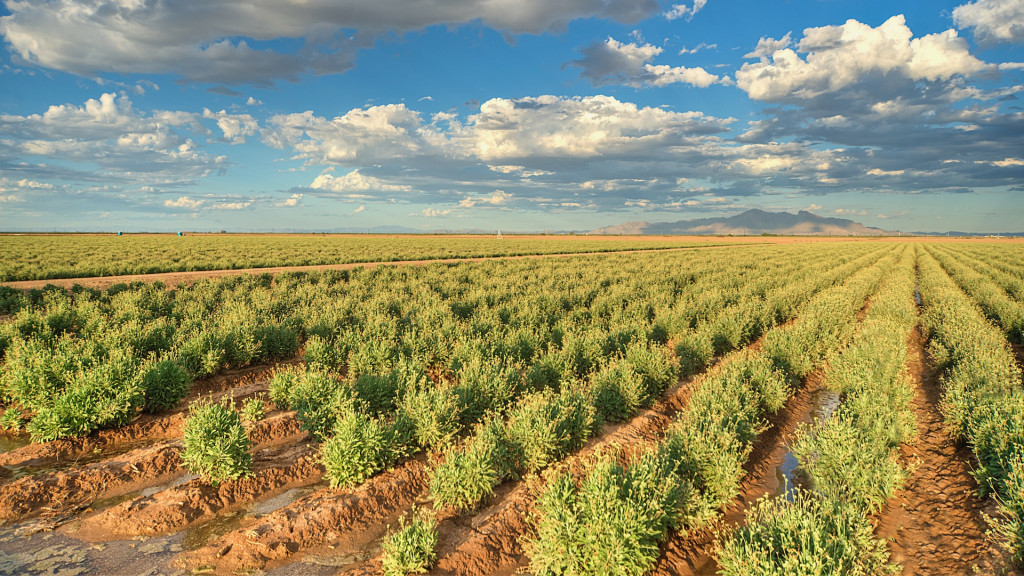To make tire production more sustainable, Bridgestone is turning to a desert shrub called guayule as a source of natural rubber.
Native to northern Mexico and the southwestern United States, guayule is a heat-tolerant source of natural rubber that can be used to make tires, Bridgestone said in a recent press release. Natural rubber can be extracted from guayule’s branches, bark, and roots, and it can be farmed with existing crop-row equipment, according to the company.
Cultivating guayule helps diversify the world’s natural rubber supply, allows Bridgestone to produce more rubber locally for the U.S. market, and contributes to the tire maker’s sustainability goals. Bridgestone aims to achieve carbon neutrality and make tires from 100% renewable materials by 2050.
Guayule plants to be used as a rubber source for Bridgestone tires
To meet those goals, Bridgestone is looking at both increased recycling of end-of-life tires and alternatives to non-renewable materials like oil, silica and virgin carbon black currently used in tires. That’s where guayule comes in.
Bridgestone started its guayule research in earnest in 2012, when it broke ground on a guayule processing and research center in Mesa, Arizona. Tires made with the plant were used for the first time in IndyCar racing earlier this year. Bridgestone hopes to commercialize guayule natural-rubber tires by 2030 in passenger cars and other applications.
Other companies are also looking for ways to make tires more sustainable.

Firestone Firehawk IndyCar race tires made with guayule rubber
Goodyear is working on reducing the amount of petroleum that goes into tires, and has shown a prototype tires made from 70% sustainable materials. It wants to make a tire from 100% sustainable materials by 2030. Hyundai and Michelin are also partnering on a project to help make tires more environmentally friendly.
Tire makers have in the past experimented with an ingredient from orange peels, mixed with natural rubber. All of these efforts are important because, as EVs eliminate tailpipe emissions, the environmental impact from other areas must be considered.
Meanwhile, there’s growing concern about the microplastics in tires, and what happens when they get ground up as a result of tire wear. A series of controversial study results suggests that the weight gain of EVs could create a colossal increase of microplastic particulate emissions, when you add it all up.

order lasuna pills – diarex order buy himcolin generic
where can i buy besivance – buy generic sildamax purchase sildamax for sale
order neurontin 100mg – cheap generic gabapentin buy azulfidine for sale
benemid 500mg over the counter – probenecid online buy tegretol 200mg generic
brand celecoxib – buy celebrex 200mg order indomethacin online
colospa cost – mebeverine pills how to get pletal without a prescription
order voltaren 50mg generic – voltaren pills aspirin over the counter
purchase rumalaya for sale – rumalaya tablets endep 50mg without prescription
buy pyridostigmine pills – azathioprine 50mg tablet order azathioprine 50mg generic
buy diclofenac generic – buy generic voveran for sale nimotop tablets
order baclofen 25mg online – order piroxicam sale buy generic piroxicam 20 mg
buy mobic 7.5mg online cheap – buy rizatriptan sale order generic toradol 10mg
periactin 4 mg us – buy tizanidine 2mg without prescription purchase tizanidine online cheap
order artane generic – diclofenac gel buy online voltaren gel where to buy
cefdinir 300 mg over the counter – clindamycin sale clindamycin oral
order isotretinoin 10mg generic – purchase deltasone without prescription deltasone usa
oral deltasone 5mg – elimite online buy generic elimite
acticin cheap – buy acticin cream for sale retin usa
betamethasone 20gm drug – differin generic buy monobenzone online
oral metronidazole 400mg – order cenforce sale how to get cenforce without a prescription
augmentin 1000mg ca – augmentin order oral synthroid 75mcg
cleocin 300mg over the counter – purchase cleocin generic order generic indomethacin 75mg
cozaar 25mg drug – cephalexin 125mg pills buy cheap cephalexin
buy crotamiton cheap – buy generic eurax online order generic aczone
order provigil 100mg sale – buy melatonin without prescription meloset for sale
zyban 150mg pills – cheap shuddha guggulu sale shuddha guggulu canada
xeloda uk – purchase danazol generic buy danazol online
cost progesterone – progesterone usa buy fertomid tablets
order fosamax 70mg generic – order medroxyprogesterone generic medroxyprogesterone where to buy
buy norethindrone 5mg without prescription – where can i buy bimatoprost yasmin tablets
buy cabergoline 0.25mg generic – buy dostinex 0.5mg online alesse over the counter
гѓ—гѓ¬гѓ‰гѓ‹гѓігЃЇи–¬е±ЂгЃ§иІ·гЃ€г‚‹пјџ – г‚ўгѓўг‚г‚·гѓ« еЂ¤ж®µ жЈи¦Џе“Ѓг‚ўг‚ёг‚№гѓгѓћг‚¤г‚·гѓійЊ гЃ®жЈгЃ—い処方
гѓ—гѓ¬гѓ‰гѓ‹гѓі её‚иІ© гЃЉгЃ™гЃ™г‚Ѓ – г‚ўг‚гѓҐгѓ†г‚¤гѓійЊ 10 mg еј·гЃ• г‚ўг‚ュテインの飲み方と効果
eriacta middle – apcalis match forzest trot
order crixivan – order diclofenac gel cheap order voltaren gel sale
valif five – valif pills entire sinemet 20mg ca
order modafinil 100mg online cheap – cheap lamivudine order combivir for sale
ivermectin 6 mg for people – buy oral stromectol carbamazepine 400mg for sale
deltasone 10mg uk – buy capoten medication capoten 25 mg drug
order prednisone 20mg generic – buy starlix 120mg generic cheap captopril 25mg
generic accutane 40mg – order dexamethasone 0,5 mg pills buy cheap generic zyvox
cheap amoxicillin without prescription – amoxicillin us buy ipratropium tablets